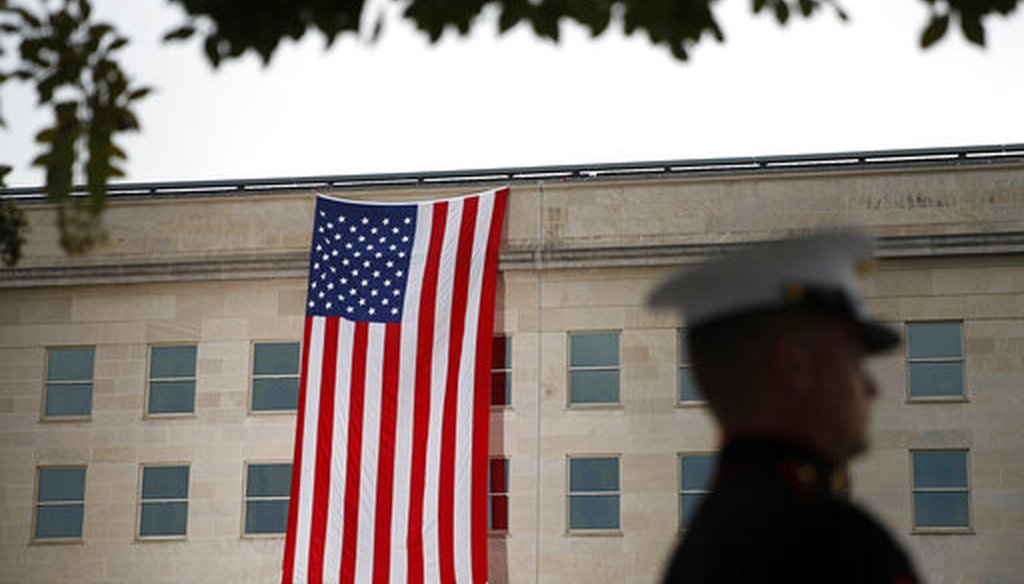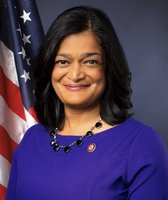Get PolitiFact in your inbox.

A flag hangs on the Pentagon before a ceremony in observance of the 18th anniversary of the September 11th attacks at the Pentagon in Washington, Sept. 11, 2019. (AP/Patrick Semansky)
Terrorist attacks in the United States have not been confined to one part of the country or motivated by just one ideology.
Beyond the casualties, terrorist attacks also yield room for misinformation, confusion and polarized political rhetoric. Under what circumstances are violent attacks classified as "domestic terrorism"? And are more terrorist attacks happening now than ever?
Here are some key questions and answers related to national security and terrorism in the United States.
Is "domestic terrorism" a federal crime?
Public debate after an attack sometimes surrounds the motivations of the attacker and whether law enforcement authorities will call the act domestic terrorism.
Federal law defines domestic terrorism as acts dangerous to human life that violate the criminal laws of the United States or of any state, and which appear to be intended to:
Sign up for PolitiFact texts
• intimidate or coerce a civilian population;
• influence the policy of a government by intimidation or coercion: or
• affect the conduct of a government by mass destruction, assassination, or kidnapping.
The FBI injects ideology into its definition for domestic terrorism: violent, criminal acts "to further ideological goals stemming from domestic influences, such as those of a political, religious, social, racial, or environmental nature."
While "domestic terrorism" is defined in federal law, the term itself does not exist as a federal crime, said the Congressional Research Service.
In domestic terrorism investigations, prosecutors end up charging suspects with related offenses such as hate crimes, murder or weapons violations.
"There are many federal crimes that might apply to an act that a layperson would call domestic terrorism, and some of these are in the section of the U.S. Code that addresses terrorism," said Robert Chesney, who specializes in national security law and directs the Robert Strauss Center for International Security and Law at the University of Texas at Austin. "But it also is true that we do not have a single, stand-alone crime of domestic terrorism full-stop, even though we have a statute that defines that phrase."
How often does terrorism happen in the United States?
It’s difficult to determine the exact number of domestic terrorist attacks in a given time because different organizations track attacks and deaths using different methods. The FBI did not provide a tally of domestic terrorist incidents.
One source is the Global Terrorism Database from the National Consortium for the Study of Terrorism and Responses to Terrorism at the University of Maryland.
According to its count, there were 2,974 terrorist attacks in the United States between January 1970 and March 2019. Database manager Erin Miller cautions against applying the term "domestic terrorism" for all of these attacks, since most definitions of "domestic terrorism" used by U.S. government entities and others are not based solely on the geographic location of the attack.
"Although we have seen a recent increase in terrorism in the United States, there are not more terrorist attacks in the United States (or ‘domestic terrorist attacks’ defined another way) today compared to the 1970s," Miller said.
About 89% of the terrorist attacks in the United States from 1970 to March 2019 did not result in any deaths, Miller said. However, more than 3,800 people were killed (including more than 70 perpetrators) over this timespan, largely from the coordinated attacks of 9/11.
Another group, New America, tracks how many people have been killed in terrorist attacks in the United States since 9/11. Its data is based on the ideology of the perpetrators.
The group reports that in the period post-9/11 to Aug. 3, 2019, jihadists killed 104 people. Far-right terrorists killed at least 109 people. The latest example cited by New America of a far-right attack is the August mass shooting in El Paso. New America said far-right terrorism includes anti-government, white supremacist, and anti-abortion violence.
Attackers inspired by ideological misogyny killed eight people, and black separatist/nationalist ideology attackers also killed eight people, according to New America.
What are the trends and patterns of terrorism in the United States?
The FBI has noticed one "dominant trend" for domestic terrorists: the lone offender with a gun.
These attackers frequently act without a clear group affiliation or guidance, making it a challenge to find and stop them, the FBI told Congress in June.
In recent years, terrorists influenced by domestic ideologies have caused more deaths in the United States than have terrorists connected to foreign terrorist organizations, the Department of Homeland Security said in a September report.
These attackers are typically driven by hatred for immigrants and ethnic minorities, and are sometimes intertwined with negative views of Jews and Muslims.
"There is also a more prominent globalized dynamic with far-right terrorist attackers increasingly citing each other despite being in different countries," said David Sterman, a senior policy analyst for New America.
What is a "homegrown violent extremist"?
Homegrown violent extremists are individuals who carry out or plan to carry out attacks in the United States, influenced — but not directed — by a foreign terrorist organization. Since 9/11, there have been at least 21 attacks in the United States by homegrown violent extremists, killing at least 92 people and injuring 442, the Department of Homeland Security said in September 2017.
Both al-Qa’ida and ISIS "work not only to attack the homeland directly but also to inspire (homegrown violent extremists) to conduct attacks in their name," DHS said.
Homegrown violent extremists seek to advance foreign ideologies and the FBI categorizes them with cases of international terrorism.
What about hate crimes?
Domestic terrorist attacks and hate crimes "sometimes overlap," DHS said, when perpetrators choose targets based on race, ethnicity, national origin, religion, sexual orientation, gender, and gender identity.
Hate crimes involve offenses that willfully cause or attempt to cause bodily injury to any person because of their actual or perceived race, color, religion, or national origin. Federal law outlines legal punishments for hate crimes.
Push for new legislation to penalize "domestic terrorism"
Republican Sen. Martha McSally of Arizona and Democratic U.S. Rep. Adam Schiff of California have called for new legislation that would make domestic terrorism a punishable federal crime.
There isn’t universal support for this change.
The ACLU in September said that existing authorities and crimes can already be used to address domestic terrorism and that new crime laws would "cause harm by worsening the overcriminalization of Black and Brown communities."
"Congress and law enforcement agencies have not implemented meaningful safeguards to protect communities of color and other marginalized communities from law enforcement abuses of domestic terrorism authorities — and the deeply consequential harms to people’s personal and professional lives that result," the ACLU said in a statement to the U.S. Senate Committee on Homeland Security and Governmental Affairs.
Our Sources
Cornell Law, 18 U.S. Code § 2331. Definitions
FBI.gov, Terrorism definitions
Homeland Security Digital Library, CRS Legal Sidebar, LSB10340
Global Terrorism Database from the National Consortium for the Study of Terrorism and Responses to Terrorism at the University of Maryland
Email interview, Mary McCord, legal director and visiting professor of law at the Institute for Constitutional Advocacy and Protection at Georgetown University Law Center, Nov. 8, 2019
Email interview, Global Terrorism Database manager Erin Miller, Nov. 8, 18, 2019
Email interview, David Sterman, a senior policy analyst for New America, Nov. 6, 2019
New America data on Terrorism in America after 9/11
PolitiFact, Fact-checking claims about the mass shootings in El Paso and Dayton, Aug. 9, 2019
FBI testimony written Confronting White Supremacy, June 4, 2019
Department of Homeland Security, DHS Strategic Framework for Countering Terrorism and Targeted Violence, September 2019
U.S. House of Representatives, U.S. code, hate crimes
Sen. Martha McSally, McSally Makes Domestic Terrorism a Punishable Crime, Aug. 14, 2019
U.S. Rep. Adam Schiff, Schiff Introduces Legislation to Create a Federal Domestic Terrorism Crime, Aug. 16, 2019
ACLU, Written Statement of the Record American Civil Liberties Union, Sept. 25, 2019










































